Chlorosplenium chlora
Scientific name: Chlorosplenium chlora (Schwein.)
M.A. Curtis
Derivation of name: Chlor- means green.
Synonyms: Peziza chlora Schwein, Helotium chlora
(Schwein.) Morgan
Common name(s): None listed.
Phylum: Ascomycota
Order: Helotiales
Family: Dermateaceae
Occurrence on wood substrate:
Saprobic; in clusters
on decaying wood; summer through fall.
Dimensions: Shallow cup to saucer-shaped, 1-3 mm
wide; margin slightly incurved, stalkless or nearly so.
Sterile outer surface: Bright yellow, roughened but not
hairy.
Fertile inner surface: Yellow at first, gradually
becoming green.
Edibility: Unknown.
Comments: This speces does not appear in many field
guides but it is not uncommon in my experience. It is quite
small, though. A good field character is the rim of the cup
which appears as a yellow circle surrounding the greenish
fertile surface.
More information at MushroomExpert.com:
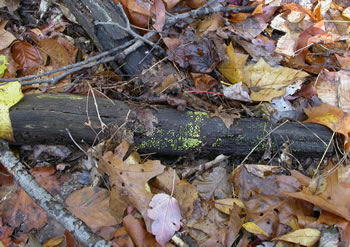
Figure 1. Clusters of Chlorosplenium chlora on a
decaying branch. Photo © Gary Emberger.
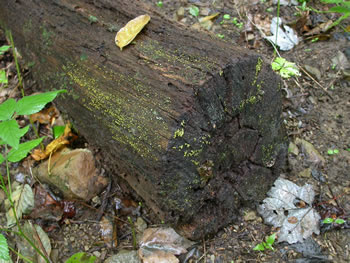
Figure 2.
If not observed carefully, Chlorosplenium
chlora can be mistaken for Bisporella citrina. The
greenish coloration of Chlorosplenium chlora, however,
is
not found with Bisporella citrina. Photo © Gary
Emberger.
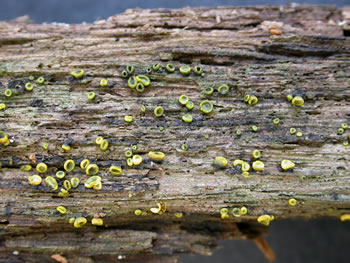
Figure 3.
Specimens at various stages of maturity with
some specimens appearing more green (i.e., more mature)
than others. Photo © Gary Emberger.
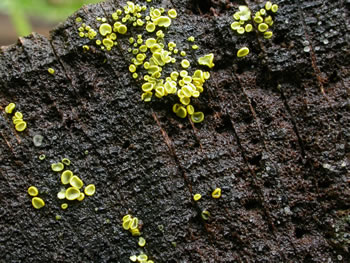
Figure 4. These specimens are growing on an oak log.
Note the thick rays, characteristic of oak wood. The
available literature indicates this fungus grows on decayed
wood and does not specify hardwoods or softwoods. I
have always found it on hardwoods. Photo © Gary
Emberger.
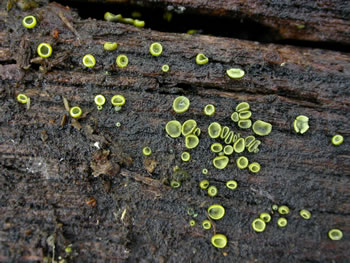
Figure 5.
The outer surface of Chlorosplenium chlora
remains yellow after the fertile surface turns green. To me,
the resultant yellow circles surrounding green centers are a
striking field characteristic. Photo © Gary Emberger.
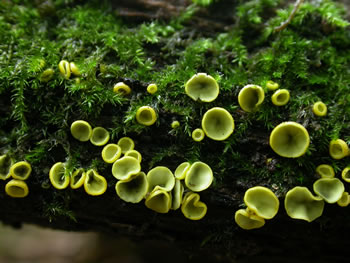
Figure 6.
A closer view of the greenish fertile areas of the
cup interiors surrounded by the yellow of the cup rims.
Photo © Gary Emberger.
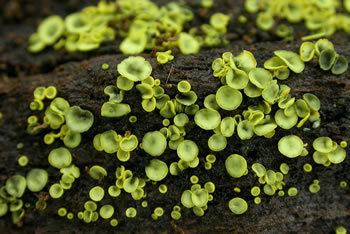
Figure 7.
The oldest specimens here are almost entirely
green. Photo © Gary Emberger.
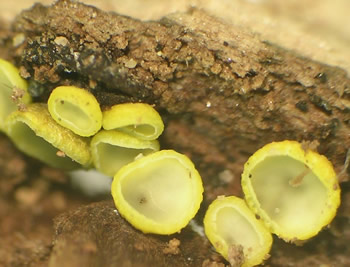
Figure 8.
The fertile inner surfaces of these young
specimens are whitish. These specimens occurred together
with the greenish specimens in the other figures. Assuming
this is the same species, the fertile surface must progress
from white to yellow and then finally green at maturity.
Photo © John Dawson.
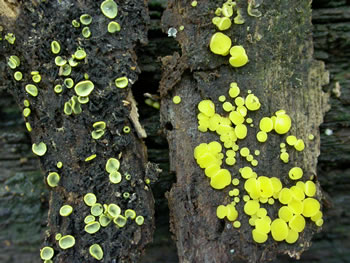
Figure 9.
Another small cup fungus, Bisporella citrina,
could potentially be confused with Chlorosplenium
chlora. Unlike Chlorosplenium chlora, the fertile inner
surface of Bisporella citrina remains yellow.
Bisporella citrina is on the
right and Chlorosplenium
chlora is on the left. Photo © Gary Emberger.